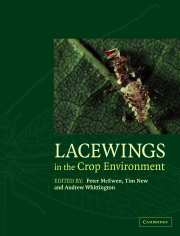Book contents
- Frontmatter
- Contents
- List of contributors
- Preface
- PART 1 Lacewing systematics and ecology
- PART 2 Lacewings in crops
- PART 3 Principles
- PART 4 Case studies
- Introduction to Part 4
- CHAPTER 18 Micromus tasmaniae: a key predator on aphids on field crops on Australasia?
- CHAPTER 19 Preliminary notes on Mallada signatus (Chrysopidae) as a predator in field crops in Australia
- CHAPTER 20 An evaluation of lacewing releases in North America
- CHAPTER 21 Chrysoperla externa and Ceraeochrysa spp.: potential for biological control in the New World tropics and subtropics
- CHAPTER 22 Comparative plant substrate specificity of Iberian Hemerobiidae, Coniopterygidae, and Chrysopidae
- CHAPTER 23 Lacewings in Sardinian olive groves
- CHAPTER 24 Lacewing occurrence in the agricultural landscape of Pianura Padana
- CHAPTER 25 Lacewings and snake-flies in Piedmont vineyards (northwestern Italy)
- CHAPTER 26 Control of aphids by Chrysoperla carnea on strawberry in Italy
- CHAPTER 27 Artificial overwintering chambers for Chrysoperla carnea and their application in pest control
- CHAPTER 28 Lacewings in Andalusian olive orchards
- CHAPTER 29 The green lacewings of Romania, their ecological patterns and occurrence in some agricultural crops
- CHAPTER 30 Biological control with Chrysoperla lucasina against Aphis fabae on artichoke in Brittany (France)
- PART 5 Conclusion
- Taxonomic index
- General index
CHAPTER 23 - Lacewings in Sardinian olive groves
Published online by Cambridge University Press: 04 May 2010
- Frontmatter
- Contents
- List of contributors
- Preface
- PART 1 Lacewing systematics and ecology
- PART 2 Lacewings in crops
- PART 3 Principles
- PART 4 Case studies
- Introduction to Part 4
- CHAPTER 18 Micromus tasmaniae: a key predator on aphids on field crops on Australasia?
- CHAPTER 19 Preliminary notes on Mallada signatus (Chrysopidae) as a predator in field crops in Australia
- CHAPTER 20 An evaluation of lacewing releases in North America
- CHAPTER 21 Chrysoperla externa and Ceraeochrysa spp.: potential for biological control in the New World tropics and subtropics
- CHAPTER 22 Comparative plant substrate specificity of Iberian Hemerobiidae, Coniopterygidae, and Chrysopidae
- CHAPTER 23 Lacewings in Sardinian olive groves
- CHAPTER 24 Lacewing occurrence in the agricultural landscape of Pianura Padana
- CHAPTER 25 Lacewings and snake-flies in Piedmont vineyards (northwestern Italy)
- CHAPTER 26 Control of aphids by Chrysoperla carnea on strawberry in Italy
- CHAPTER 27 Artificial overwintering chambers for Chrysoperla carnea and their application in pest control
- CHAPTER 28 Lacewings in Andalusian olive orchards
- CHAPTER 29 The green lacewings of Romania, their ecological patterns and occurrence in some agricultural crops
- CHAPTER 30 Biological control with Chrysoperla lucasina against Aphis fabae on artichoke in Brittany (France)
- PART 5 Conclusion
- Taxonomic index
- General index
Summary
INTRODUCTION
Chrysopid taxocoenoses of the olive agroecosystem are well known and have been studied in nearly all Mediterranean countries (Canard & Laudého, 1977, 1980; Canard, 1979; Canard et al., 1979; Alrouechdi et al., 1980a, b; Neuenschwander & Michelakis, 1980; Neuenschwander et al., 1981; Neuenschwander, 1982; Campos & Ramos, 1983; Yayla, 1983; Alrouechdi, 1984; Liber & Niccoli, 1988). Pantaleoni & Curto (1990) suggested that they were influenced by environmental conditions such as the spatial pattern of trees, chemical treatments, and the surrounding vegetation, besides zoogeography.
The results of adult captures, where the species of the genus Dichochrysa often dominate, are, however, in contrast with the larval collection results, where Chrysoperla carnea (Stephens) s. lat. is by far the most abundant species, to the point that this species is practically considered the only chrysopid species developing on olive trees (Alrouechdi et al., 1980a; Neuenschwander & Michelakis, 1980). Some doubts on this conclusion were raised by Pantaleoni & Curto (1990) and Pantaleoni et al. (1993) who suggested that the efficiency of different sampling methods can be influenced by the behaviour of the different chrysopid genera and for these reasons the presence of some species can easily be underestimated.
The key pests in Sardinian olive agricultural systems are the olive fly, Bactrocera oleae (Rossi), the olive moth, Prays oleae (Bernard), and the black olive scale, Saissetia oleae (Olivier). Chrysopids can prey on the last two and are considered important predators of the olive moth (Ramos & Ramos, 1990).
- Type
- Chapter
- Information
- Lacewings in the Crop Environment , pp. 435 - 446Publisher: Cambridge University PressPrint publication year: 2001
- 2
- Cited by



